BY LAEL LOEWENSTEIN
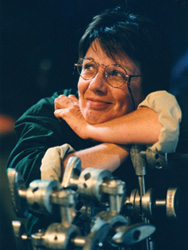 When TITANIC director James Cameron asked
When TITANIC director James Cameron asked
UPM Sharon Mann why she was coming
aboard what many thought was a sinking
ship, she said it was the "E-Ticket in town."
When Sharon Mann arrived in Mexico as the newly installed production manager on Titanic, she was jumping aboard a project reportedly awash in cost overruns, internal strife, production difficulties, and enough bad buzz to make its title seem eerily prophetic.
It was a tall order for any UPM, let alone one without the benefit of prep time. When they met for the first time, James Cameron asked Mann what on earth had possessed her to enter the fray.
"This is the E-ticket in town," Mann grinned back without hesitation. "Who wouldn't want to be here?"
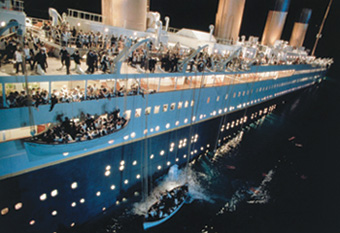 (Credits: Merie Wallace/Paramount Pictures)
(Credits: Merie Wallace/Paramount Pictures)
To Mann and her fellow UPMs, the bigger the challenge, the better the ride. And the bigger the budget, the more complex and daunting the challenges.
No one knows that better than Barry Waldman. A Jerry Bruckheimer favorite, Waldman has managed some of Hollywood's biggest productions. But whether the job involves staging an elaborate water sequence (National Treasure) or devising ways to blow up a ferry (Déjà Vu), the biggest challenge remains staying within budget. "It always seems like a lot of money on paper," Waldman says, "but it's never enough." Adds Dean Jones (Body of Lies), "You're constantly waging a battle between the director's vision on the one hand and the constraints of the budget on the other." And yet a UPM must strike a nonpartisan tone in all relationships. "You have to have loyalties," Mann allows, "to what can be competing interests."
Patricia Whitcher, for instance, had to deploy her negotiation skills while prepping Dreamgirls with Bill Condon. When Paramount production executives flinched at the musical's $70 million price tag entrusted to a director with no big-budget track record, Whitcher arranged a set visit to allay their anxieties. That visit, involving in-depth demonstrations, dance numbers and assorted pre-visualizations, was exactly what was needed: It assuaged the studio and allowed Condon, Whitcher and their team to continue their work unfettered.
"Patty was a great ally and an expert at working through the studio system," notes Condon. "She could explain to the studio when and why things were necessary." And because Whitcher had ample experience with large budgets and complicated shoots on such films as True Lies, she also helped ease Condon's transition to a more commercial production. "I was getting used to a whole new level of machinery," Condon recalls of the extensive preproduction process, "and she was able to remind me how much was at my disposal."
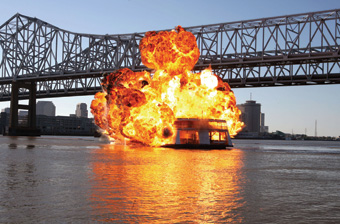 (Credit: Touchstone/Everett)
(Credit: Touchstone/Everett)
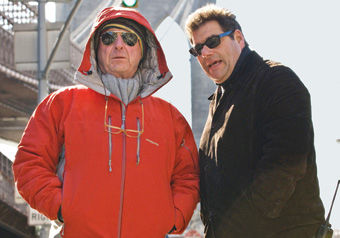
Barry Waldman (above, right) helped director Tony Scott retool the
spectacular ferry explosion at the beginning of DÉJÀ VU (top).
(Credit: Myles Aronowitz/Columbia Pictures)
Comprehensive prep work helps alleviate snafus down the road, if not avoid them altogether. "If you prep a movie properly," notes Waldman, "then you don't have much of a job to do during shooting." A UPM needs to anticipate problems before they arise and be ready with a contingency plan if and when they do. "The best UPMs," agrees Whitcher, "are proactive, not reactive."
Still, sometimes no amount of preparation can prevent a crisis. Weather and health remain two of the most unpredictable and uncontrollable elements in a production. Mann, for instance, could no better have predicted the hurricane that sidelined Bound by Honor than she could have prevented Martin Lawrence's illness on Nothing to Lose. But resilience and adaptability are a UPM's stock in trade: In the former case, the Taylor Hackford film fell behind schedule; in the latter, Mann altered the schedule so director Steve Oedekerk could shoot around Lawrence until his return. And sometimes there is no choice but to adjust one's expectations. Shooting The Jungle Book with Stephen Sommers, Mann quickly found that the four-legged cast members wouldn't always hit their marks. "You're not going to get 30 setups a day working with animals," says Mann. "You're lucky if you get 10."
At times, even the best-laid plans don't yield the expected results. Having pushed the envelope with their technological innovations on The Matrix, the Wachowski brothers intended to shoot portions of their back-to-back sequels in zero gravity, and elicited permission from Warner Bros. to do just that. But as UPM Jones discovered during four days of rain and martial arts test sequences, almost no one could withstand the nausea-inducing G-forces of the "vomit comet," so the plan was scrapped and the sequences composed digitally.
For Jones, the three-and-a half years he spent on The Matrix: Revolutions and The Matrix: Reloaded (including a full year of prep on each) were all-consuming, whereas a low-budget film or TV pilot, by contrast, "can be quite freeing." Large-scale success brings its privileges, though: Had The Matrix not been such a blockbuster, Warner Bros would never have funded the costly zero-gravity experiments in the first place.
Jones likens the job to that of a camp counselor. "It's a business of personalities," he says, "and the UPM has to help the different personalities involved adapt to one another. You have to listen to the director and know what he or she is trying to achieve, but you also have to tell the truth about the financial realities of the picture."
Discerning the best ways to line up a director's creative vision with the financial realities of a picture often requires a good UPM to think outside of the box. For example, on Memoirs of a Geisha plans had originally called for shooting in Japan. But between the escalating costs of international production, the sociopolitical constraints of depicting geisha culture in Japan, and the prospective complications of having to redress modern Kyoto for the film's cinematic period, the Rob Marshall production reset for California with a short second unit shoot in Japan.
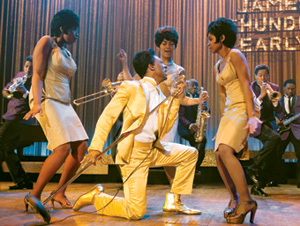 (Credit: David James/DreamWorks/Everett)
(Credit: David James/DreamWorks/Everett)
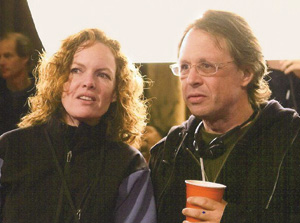
When Paramount balked at the $70 million budget for
Dreamgirls, UPM Patricia Whitcher arranged a set
visit and got director Bill Condon what he needed.
(Credit: David James/DreamWorks)
When Marshall needed to cast an authentic-looking sumo wrestler, Whitcher looked far and wide for the real thing, only to discover that the sumo's strict code of honor prevents them from engaging in public performance. Casting sessions yielded no one convincing—until Whitcher found a loophole in the sumo code that granted a special dispensation to freshly retired sumo wrestlers. "Sometimes," she says, "it's just a matter of asking the one question that somebody missed; it can bring clarity to the process."
"Failure," she adds, "is not an option. You cannot take no for an answer." (One director's affectionate sobriquet for her is "The Velvet Hammer.")
But a UPM also has to know when and where to compromise. As the bridge between the creative and financial ends of a production, a UPM also acts as a facilitator between the above-the-line and below-the-line players, and as a link between the various production departments. The job requires excellent communication skills, a gift for multi-tasking, and the conciliatory approach of a diplomat embarking on an international peace treaty. It's no wonder Whitcher's friends joke that she should be working for the U.N.
By extension, a UPM also serves as a kind of global ambassador for the film industry. When trying to secure locations for the National Treasure films—Mount Rushmore and the Library of Congress among them—Waldman was conscious that the impression he left could impact the course of future productions. "You want them to have a good experience," he says of the local officials and liaisons who granted permission to film, "not just for yourself but for the next guys."
And so in his dealings with the National Park Service and the U.S. Department of the Interior, Waldman often found creative ways to get what he needed for director Jon Turteltaub. While negotiating to shoot at Philadelphia's Independence Hall, for instance, Turtletaub and Bruckheimer agreed to produce an educational documentary DVD that Waldman would facilitate, a bargaining chip that sealed the deal.
Waldman's ability to seek out creative solutions was essential in coordinating a trio of Michael Bay projects. To shoot Pearl Harbor in Hawaii, Waldman and fellow exec producer Bruce Hendricks arranged a meeting for Bruckheimer and Bay to convince 40 commanders that the material would be handled with sensitivity. And for The Rock, Waldman had to promise that the production—the first major one on Alcatraz in more than two decades—would never be visible to tourists. Logistical challenges there included the installation of two 10,000 gallon water tanks, arranging for a crane barge to transport five trailers across San Francisco Bay, and circumventing the lead paint that rendered a good portion of the island a hazmat risk.
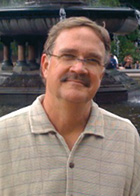 Dean Jones says the three-and-half years he spent
Dean Jones says the three-and-half years he spent
working on The Matrix: Revolutions and The
Matrix: Reloaded were all-consuming.
In some cases a UPM has to anticipate challenges that have yet to be conceived. For the climactic water sequence in National Treasure: Book of Secrets, Waldman had to oversee the creation of a set piece whose pages had yet to be written, one which would require three waterfalls and extensive plumbing. A recipe for disaster? Not for Waldman: "You build the set to cover what comes out of the writers," he says. But on the first night of shooting, the water began to foam unexpectedly, and the entire set "started to look like a theme park." Waldman found an anti-foam agent and sent his crew to skim the foam off the water until shooting could start again.
Even top UPMs admit they sometimes have to deliver bad news, of course, but "if I'm ever delivering a problem," says Waldman, "it always comes with a solution. Sometimes you have to spend a little to save a lot."
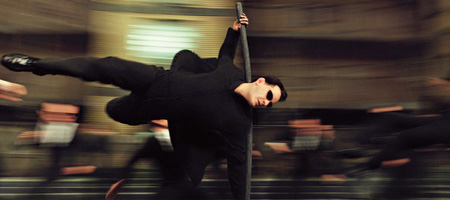 (Credit: Warner Bros.)
(Credit: Warner Bros.)
Mapping out the spectacular opening ferry explosion for Déjà Vu, for instance, Waldman quickly became aware that the initial plan—staging an elaborate massacre as scores of sailors were sent, bodies ablaze, into the sea—would be prohibitively expensive. After talking with Bruckheimer, Waldman met with director Tony Scott. Waldman asked Scott whether he thought it made sense to spend the time and money depicting the deaths of people the audience would have no connection to. Scott reconsidered, agreeing that it could be far more effective to show a suggestive flash of the human death toll.
"When Barry comes to you with a creative suggestion, you know he's trying to solve a budget problem," says Turteltaub. "But Barry says yes more than anyone I know. He never says no upwards [in the production hierarchy], although the prop guys are probably told no a lot. And by the time Barry comes to you with a problem, you know he's tried 50 other things first. He's completely unflappable, he keeps the machine running, and he can talk you off the ledge as you're pushing him out onto it."
Indeed, Waldman agrees it's essential to project an air of calm control, no matter how seemingly insurmountable the crisis at hand. "The set could be on fire and the trailers could be blowing up around you," he says. "But when you answer the phone, everything is fine."